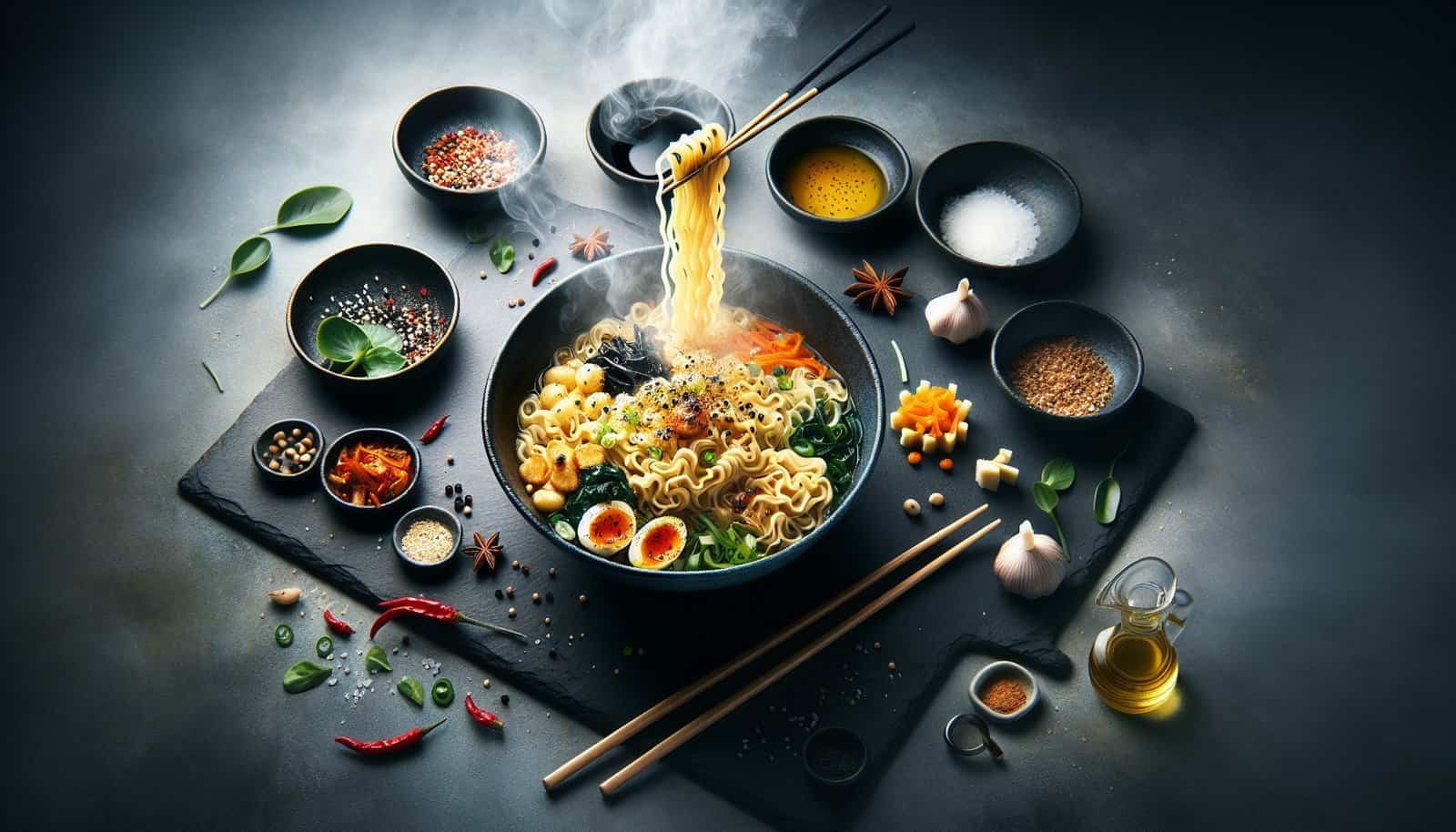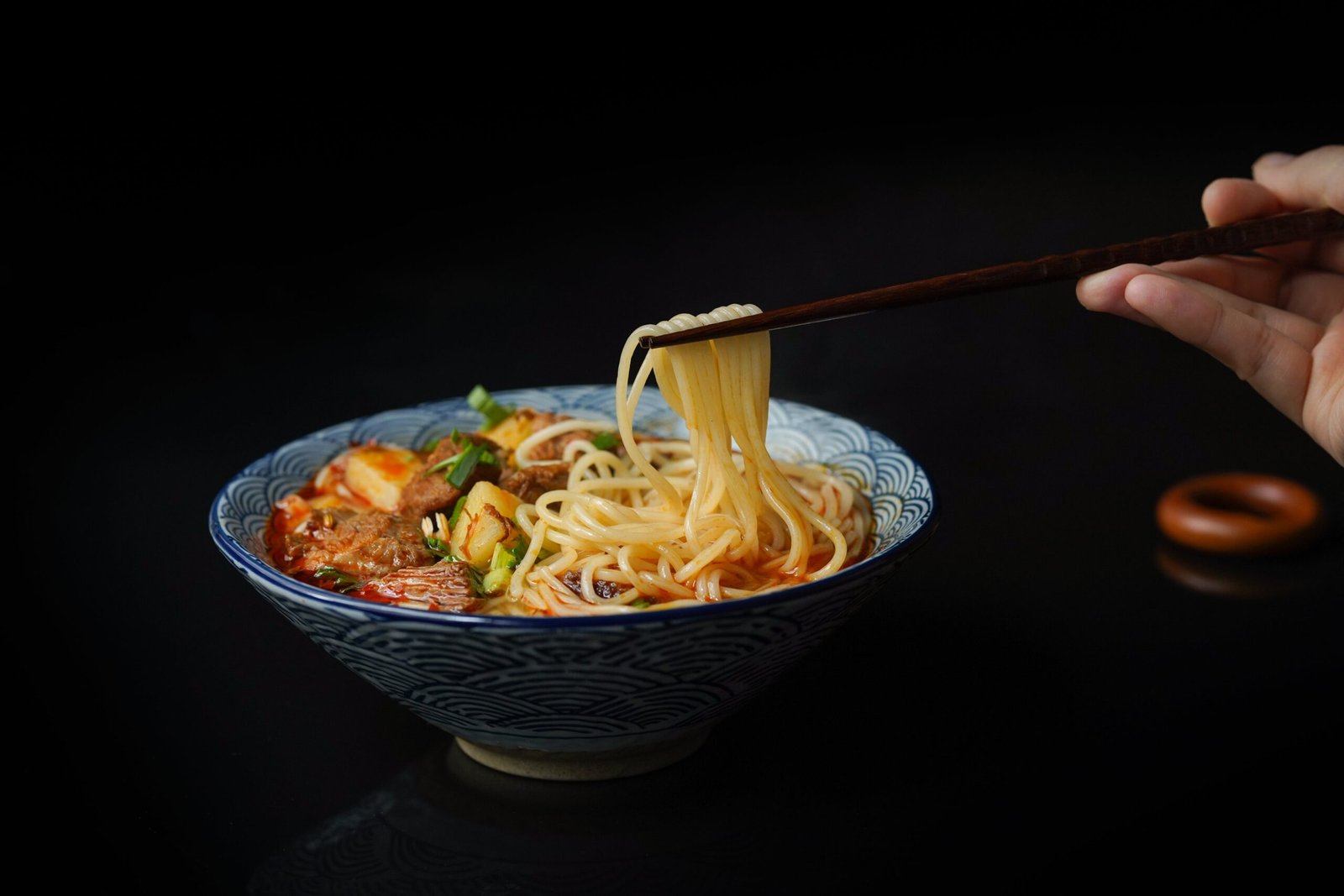If you’re a fan of Korean cuisine and enjoy a hearty bowl of noodles, then this article is a must-read for you! We’ll be exploring the world of Korean noodle dishes and the exciting possibilities they offer when it comes to preparation and presentation. From classic favorites like Japchae and Bibim Guksu to lesser-known options such as Mul Naengmyeon and Kalguksu, we’ll show you how to elevate your noodle game to a whole new level. Get ready to tantalize your taste buds with innovative and creative ideas that will surely impress your friends and family.
Different Types of Korean Noodles
Japchae
Japchae is a classic Korean noodle dish made with sweet potato glass noodles. The noodles are stir-fried with assorted vegetables and seasoned with soy sauce and sesame oil. It is often garnished with thinly sliced beef or mushrooms. Japchae is a popular dish for special occasions and gatherings due to its vibrant colors and delicious flavors.
Naengmyeon
Naengmyeon is a refreshing Korean noodle dish that is perfect for hot summer days. It consists of cold buckwheat noodles served in a tangy broth made from beef, chicken, or dongchimi (radish water kimchi). The noodles are topped with pickled cucumbers, boiled egg slices, and sometimes even slices of cold beef or kimchi. Naengmyeon is a popular dish in Korea and is often enjoyed as a light lunch or dinner.
Jajangmyeon
Jajangmyeon is a popular Korean-Chinese noodle dish made with thick, wheat-based noodles and a rich black bean sauce. The sauce is made from fermented black soybeans, onions, pork, and various vegetables. Jajangmyeon is often garnished with cucumber slices and enjoyed with side dishes such as danmuji (pickled radish) or kimchi. It is a comforting and satisfying noodle dish that is loved by many.
Bibim Guksu
Bibim Guksu is a spicy Korean cold noodle dish that is perfect for those who love bold flavors. It consists of thin wheat noodles tossed in a spicy sauce made from gochujang (Korean red pepper paste), vinegar, soy sauce, and sugar. The noodles are then topped with julienned vegetables, boiled egg slices, and sometimes even slices of beef or kimchi. Bibim Guksu is often enjoyed during hot summer days and is a popular street food in Korea.
Kalguksu
Kalguksu is a hearty Korean noodle soup made with handmade, knife-cut wheat noodles. The soup is often made with a rich chicken or seafood broth and is served with various toppings such as sliced green onions, shredded chicken or seafood, and sometimes even dumplings. Kalguksu is a popular comfort food in Korea, especially during the cold winter months.
Creative Noodle Presentations
Noodle Salad Bowls
Noodle salad bowls are a healthy and refreshing way to enjoy Korean noodles. Simply cook your favorite Korean noodles and toss them with fresh vegetables such as cucumbers, carrots, and bell peppers. Add a flavorful dressing made with soy sauce, sesame oil, and lime juice to enhance the flavors. You can also add proteins like grilled chicken or tofu to make it a complete meal. Noodle salad bowls are not only delicious but also visually appealing.
Noodle Sushi Rolls
Noodle sushi rolls are a unique twist on traditional sushi rolls. Instead of using rice, substitute it with cooked Korean noodles. Lay the noodles on a sheet of seaweed, add your favorite fillings such as cucumber, avocado, and pickled radish, and roll it tightly. Slice the roll into bite-sized pieces and serve with soy sauce and wasabi. Noodle sushi rolls are a fun and creative way to enjoy Korean noodles while adding a touch of Japanese influence.
Noodle Sandwiches
Noodle sandwiches are a great option for those who prefer a portable and handheld meal. Cook your Korean noodles and toss them with your choice of sauce, such as gochujang or soy sauce. Spread a generous amount of the noodles onto a slice of bread and top it with fresh vegetables like lettuce, cucumber, and sliced radish. Add protein like thinly sliced beef or chicken, and another slice of bread on top. Noodle sandwiches are a tasty and convenient way to enjoy Korean noodles on the go.
Noodle Pizza
Noodle pizza is a unique fusion dish that combines the flavors of Korean noodles with the Italian classic. Cook your Korean noodles and toss them with a flavorful sauce such as gochujang or black bean sauce. Spread the noodles onto a pre-made pizza crust and top it with cheese, vegetables, and your choice of protein. Bake the pizza in the oven until the cheese is melted and bubbly. Noodle pizza is a delicious and creative way to enjoy the best of both Korean and Italian cuisines.
Noodle Soup Dumplings
Noodle soup dumplings, also known as “jiaozi,” are a delightful combination of Korean noodles and Chinese dumplings. Cook your favorite Korean noodles and let them cool slightly. Place a spoonful of the noodles in the center of a dumpling wrapper and fold it into the desired shape. Steam the dumplings until they are cooked through and serve them with a flavorful dipping sauce. Noodle soup dumplings are a unique and tasty way to enjoy the comforting flavors of both noodles and dumplings.
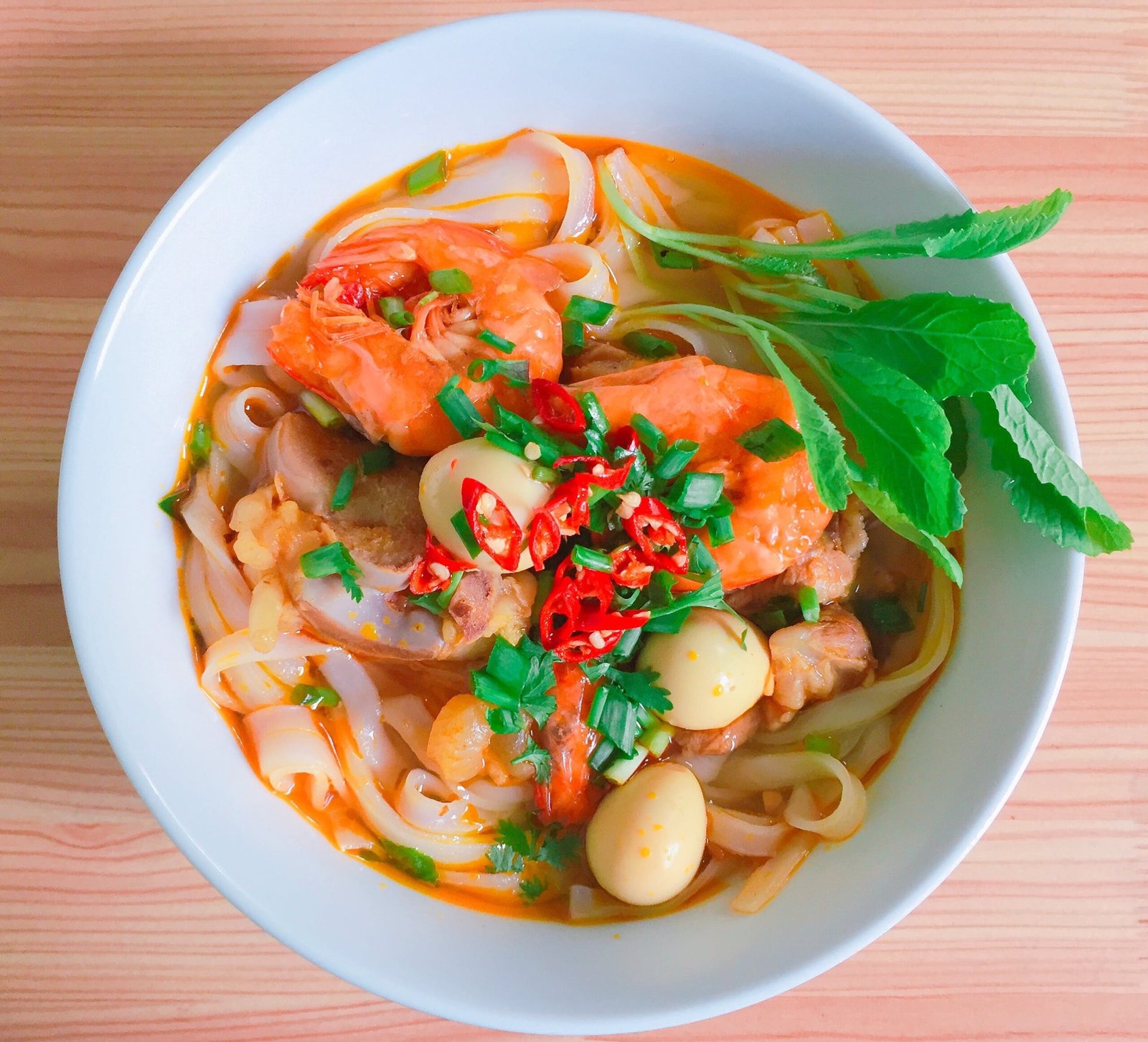
Innovative Noodle Toppings
Crispy Seaweed
Crispy seaweed is a popular topping that adds a unique texture and umami flavor to Korean noodles. Simply roast or deep-fry sheets of seaweed until they become crispy and brittle. Crumble the seaweed into small pieces and sprinkle them over your cooked noodles. The crispy seaweed adds a delicious crunch and a hint of oceanic flavor to your dish.
Kimchi
Kimchi is a staple in Korean cuisine and is often used as a topping for various dishes, including noodles. The tangy and spicy flavor of kimchi pairs well with the savory taste of Korean noodles. Simply chop the kimchi into small pieces and add it to your cooked noodles. The kimchi will not only add a burst of flavor but also provide a refreshing and crunchy element to your dish.
Fried Egg
A fried egg is a simple yet satisfying topping for Korean noodles. Cook your favorite style of egg, whether it is sunny-side-up, over-easy, or poached, and place it on top of your cooked noodles. The richness and creaminess of the egg yolk complement the flavors of the noodles and add a velvety texture to the dish.
Grilled Meat
Grilled meat, such as beef bulgogi or chicken, is a popular topping for Korean noodles. Cook the meat with your desired seasonings, slice it into thin strips, and place it on top of your cooked noodles. The savory and smoky flavors of the grilled meat add depth and richness to the dish, making it even more satisfying.
Pickled Vegetables
Pickled vegetables, such as pickled radish or cucumbers, are a great way to add a tangy and refreshing element to Korean noodles. Simply slice the vegetables into thin strips, pickle them in a mixture of vinegar, sugar, and salt, and let them sit for a few hours to develop their flavors. Drain the pickled vegetables and sprinkle them over your cooked noodles. The pickled vegetables provide a burst of acidity and crunchiness that balances the richness of the noodles.
Exploring Flavor Combinations
Soy Sauce and Sesame Oil
Soy sauce and sesame oil are classic Korean flavorings that complement the taste of Korean noodles perfectly. Drizzle a small amount of soy sauce and sesame oil over your cooked noodles and toss them to evenly coat the noodles. The soy sauce adds a savory and salty flavor, while the sesame oil adds a nutty and aromatic note. This simple combination enhances the natural flavors of the noodles and creates a delicious umami taste.
Gochujang and Honey
Gochujang, a Korean red pepper paste, and honey create a fiery and sweet combination that adds a unique flavor profile to Korean noodles. Mix gochujang and honey in a bowl until well combined, then toss your cooked noodles in the sauce. The gochujang provides a spicy kick, while the honey adds a touch of sweetness and helps balance the heat. This combination creates a harmonious blend of flavors that will tantalize your taste buds.
Peanut Sauce
Peanut sauce is a versatile and delicious condiment that adds a creamy and nutty flavor to Korean noodles. Combine peanut butter, soy sauce, lime juice, honey, and a touch of chili paste in a bowl and whisk until smooth. Toss your cooked noodles in the peanut sauce and garnish with chopped peanuts and sliced green onions. The peanut sauce adds richness and depth to the noodles, making them irresistible.
Black Bean Sauce
Black bean sauce is a savory and aromatic condiment that pairs well with Korean noodles. Stir-fry minced garlic, minced ginger, and fermented black beans in a hot pan until fragrant. Add soy sauce, sugar, and a splash of water to create a thick sauce. Toss your cooked noodles in the black bean sauce and garnish with sliced green onions. The black bean sauce adds a complex and umami-rich flavor to the noodles, taking them to a whole new level.
Spicy Tofu Sauce
Spicy tofu sauce is a flavorful and creamy sauce that adds a spicy and tangy kick to Korean noodles. Blend silken tofu, soy sauce, gochujang, vinegar, garlic, and sesame oil in a blender until smooth. Heat the spicy tofu sauce in a pan, then toss your cooked noodles in it. The creamy and spicy sauce coats the noodles, adding a burst of flavor and satisfying texture.
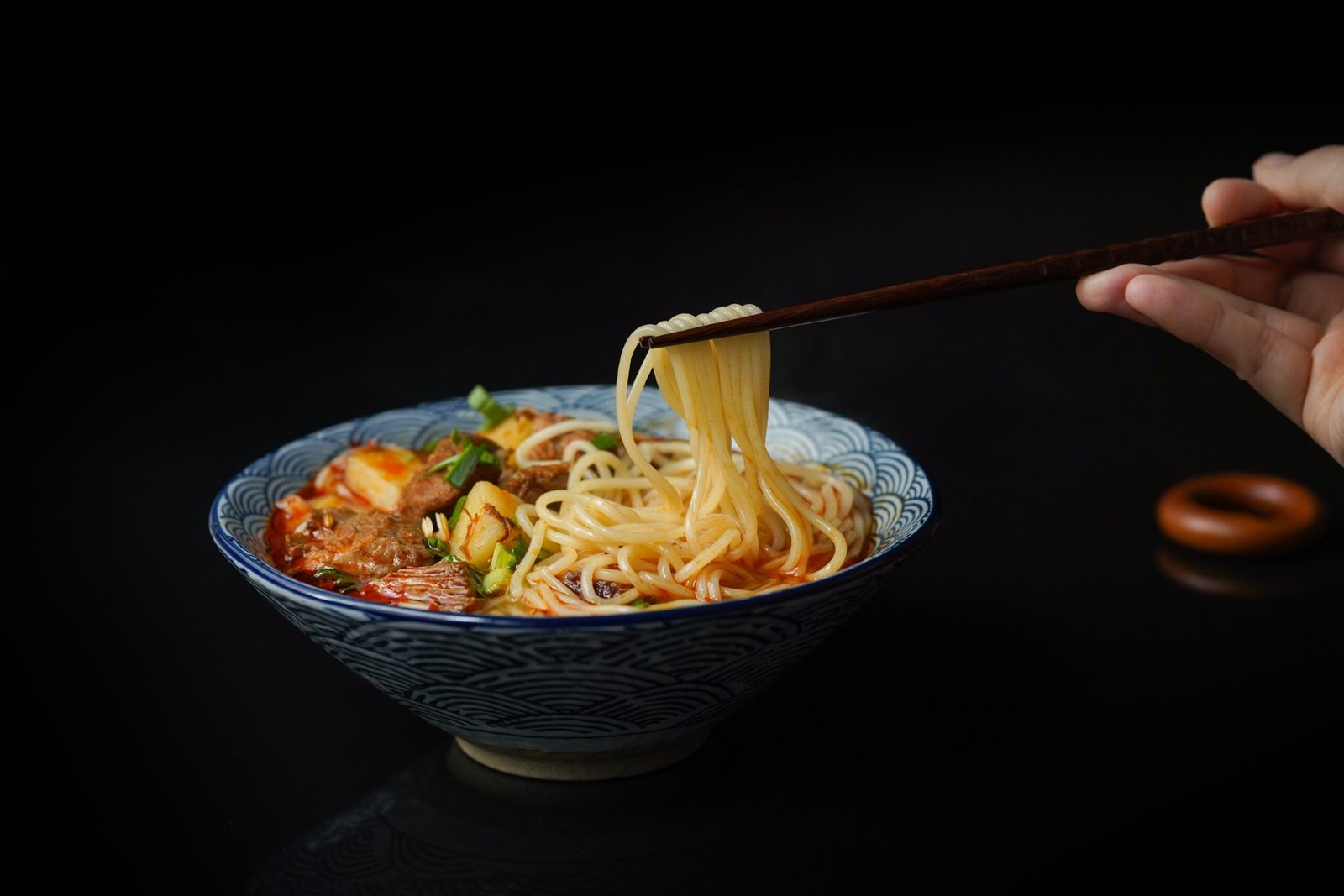
Creative Noodle Wrappings
Cucumber Wraps
Cucumber wraps are a refreshing and low-carb alternative to traditional noodle dishes. Use a vegetable peeler to create long, thin strips of cucumber, then blanch them in boiling water for a few seconds to soften. Pat the cucumber strips dry and use them as a wrapper for your favorite cooked Korean noodles. The cool and crisp texture of the cucumber adds a refreshing element to the dish, while the noodles provide a flavorful filling.
Lettuce Wraps
Lettuce wraps are a popular choice for those looking for a light and healthy meal. Choose large lettuce leaves such as romaine or butter lettuce and wash them thoroughly. Pat them dry and use them as a wrap for your cooked Korean noodles. The fresh and crunchy lettuce adds a pleasant contrast to the soft and flavorful noodles, creating a satisfying and guilt-free dish.
Rice Paper Wraps
Rice paper wraps are a versatile option that allows you to enjoy Korean noodles in a Vietnamese-inspired way. Dip a sheet of rice paper in warm water to soften it, then place a small amount of your cooked noodles on one end. Roll the rice paper tightly, tucking in the sides as you go. The rice paper provides a delicate and chewy texture, while the noodles offer a delicious filling. Serve the rice paper rolls with a dipping sauce of your choice for added flavor.
Tortilla Wraps
Tortilla wraps are a fusion twist on Korean noodles that adds a Mexican flair to the dish. Warm a tortilla on a hot skillet, then place a generous amount of your cooked Korean noodles on it. Add your favorite toppings such as salsa, avocado, and cheese, then roll up the tortilla tightly. The combination of the soft tortilla, flavorful noodles, and zesty toppings creates a delicious and satisfying meal.
Scallion Pancake Wraps
Scallion pancake wraps offer a unique and savory way to enjoy Korean noodles. Cook scallion pancakes until crispy on both sides, then remove them from the heat and let them cool slightly. Place a layer of your cooked Korean noodles on the scallion pancake, then roll it up tightly. The crispy texture of the pancake pairs well with the soft noodles, and the scallions add a burst of flavor. Cut the pancake wraps into bite-sized pieces for a fun and appetizing presentation.
Fusion Noodle Dishes
Korean-Mexican Noodle Tacos
Korean-Mexican noodle tacos combine the flavors of Korean noodles with the vibrant and bold spices of Mexican cuisine. Cook your favorite Korean noodles and toss them with a spicy gochujang-based sauce. Heat tortillas on a hot skillet, then add a generous amount of the noodles to each tortilla. Top the tacos with fresh ingredients such as salsa, sour cream, and chopped cilantro. The combination of the spicy Korean noodles and the fresh toppings creates a mouthwatering fusion of flavors.
Korean-Italian Noodle Carbonara
Korean-Italian noodle carbonara is a creative twist on the classic Italian pasta dish. Cook your favorite Korean noodles and toss them with a creamy sauce made from eggs, parmesan cheese, and Korean chili flakes. Add crispy bacon or pancetta for an extra savory touch. The combination of the rich and creamy sauce with the chewy Korean noodles creates a luxurious and satisfying dish that will impress your taste buds.
Korean-Indian Curry Noodles
Korean-Indian curry noodles bring together the aromatic flavors of Indian cuisine with the comfort of Korean noodles. Cook your favorite Korean noodles and toss them with a fragrant curry sauce made from spices such as cumin, coriander, and turmeric. Add cooked chicken or tofu for protein and garnish with fresh cilantro. The blend of the bold Indian curry flavors and the satisfying Korean noodles creates a unique and tasty fusion dish.
Korean-American Noodle Burgers
Korean-American noodle burgers combine the love for Korean flavors with the convenience of a classic American burger. Cook your favorite Korean noodles and allow them to cool slightly. Form the noodles into patties and cook them on a hot skillet until crispy. Serve the noodle patties on a bun with traditional burger toppings such as lettuce, tomato, and pickles. The crispy noodle patty brings a unique texture to the burger, while the Korean flavors add a delicious twist.
Korean-Japanese Ramen Rolls
Korean-Japanese ramen rolls bring together the best of both Korean and Japanese cuisines. Cook your favorite Korean noodles and toss them with a flavorful soy-based sauce. Lay a sheet of seaweed on a bamboo sushi mat, place a layer of the cooked noodles on top, and roll it tightly. Slice the roll into bite-sized pieces and serve with soy sauce for dipping. The combination of the Korean noodles and the Japanese seaweed creates a harmonious blend of flavors that will satisfy your cravings.

Incorporating Local Ingredients
Seasonal Vegetables
Incorporating seasonal vegetables into your Korean noodle dishes adds freshness and vibrancy to the flavors. Use vegetables that are in season, such as zucchini, bell peppers, or spinach, and cook them with your noodles. The seasonal vegetables not only enhance the nutritional value of the dish but also add a pop of color and subtle flavors that complement the noodles.
Fresh Seafood
If you have access to fresh seafood, incorporating it into your Korean noodle dishes elevates the flavors to a whole new level. Add ingredients like shrimp, squid, or mussels to your noodle dishes and cook them together to infuse the seafood flavors into the noodles. The fresh seafood adds a delightful oceanic taste and a soft texture that pairs well with the noodles.
Locally-Sourced Meat
Using locally-sourced meat in your Korean noodle dishes not only supports local farmers but also ensures the quality and freshness of the meat. Whether it’s beef, pork, or chicken, opt for meat that is locally raised and free from hormones and antibiotics. The high-quality meat will enhance the flavors of the noodles and provide a rich and satisfying protein source.
Indigenous Herbs and Spices
Incorporating indigenous herbs and spices into your Korean noodle dishes adds a unique and local touch to the flavors. Look for herbs and spices that are native to your region and experiment with using them in your cooking. Whether it’s fresh cilantro, Thai basil, or lemongrass, the indigenous herbs and spices will add depth and complexity to your Korean noodles, making them even more flavorful.
Traditional Condiments
Using traditional condiments that are specific to your region in your Korean noodle dishes adds an authentic touch to the flavors. Look for local condiments such as hot sauces, chili pastes, or fermented products that are made in your area. These traditional condiments will add a distinct and localized flavor profile to your Korean noodles, making them truly unique.
Healthy and Gluten-Free Alternatives
Zucchini Noodles
Zucchini noodles, also known as zoodles, are a healthy and gluten-free alternative to traditional Korean noodles. Use a spiralizer or a julienne peeler to create thin, noodle-like strips from fresh zucchini. Blanch the zucchini noodles in boiling water for a few seconds to soften them, then use them as a substitute in your favorite Korean noodle recipes. The zucchini noodles provide a low-carb option that is packed with nutrients and adds a fresh and crisp texture to your dish.
Sweet Potato Noodles
Sweet potato noodles, also known as dangmyeon, are a gluten-free noodle option made from sweet potato starch. These translucent and chewy noodles are a popular ingredient in Korean cuisine and are widely used in dishes such as Japchae. Cook the sweet potato noodles according to the package instructions and use them as a substitute for wheat-based noodles in your favorite Korean noodle recipes. The sweet potato noodles add a slightly sweet and earthy flavor to the dish, making it even more interesting.
Buckwheat Noodles
Buckwheat noodles, also known as soba noodles, are a nutritious and gluten-free alternative to regular Korean noodles. These noodles are made from a combination of buckwheat flour and wheat flour, making them suitable for those with a gluten intolerance. Cook the buckwheat noodles according to the package instructions and use them as a substitute in your favorite Korean noodle recipes. The nutty and earthy flavor of the buckwheat adds a unique taste to the dish.
Rice Noodles
Rice noodles are a versatile and gluten-free option that can be used in a variety of Korean noodle dishes. These noodles are made from rice flour and are available in various thicknesses and shapes. Cook the rice noodles according to the package instructions and incorporate them into your favorite Korean noodle recipes. The rice noodles have a light and delicate texture that absorbs the flavors of the dish beautifully.
Bean Sprout Noodles
Bean sprout noodles are a healthy and gluten-free alternative that brings a unique twist to Korean noodle dishes. These noodles are made from mung bean sprouts that have been processed into thin and translucent strands. Cook the bean sprout noodles according to the package instructions and use them as a substitute in your favorite Korean noodle recipes. The bean sprout noodles have a crisp texture and a mild flavor that pairs well with various sauces and toppings.
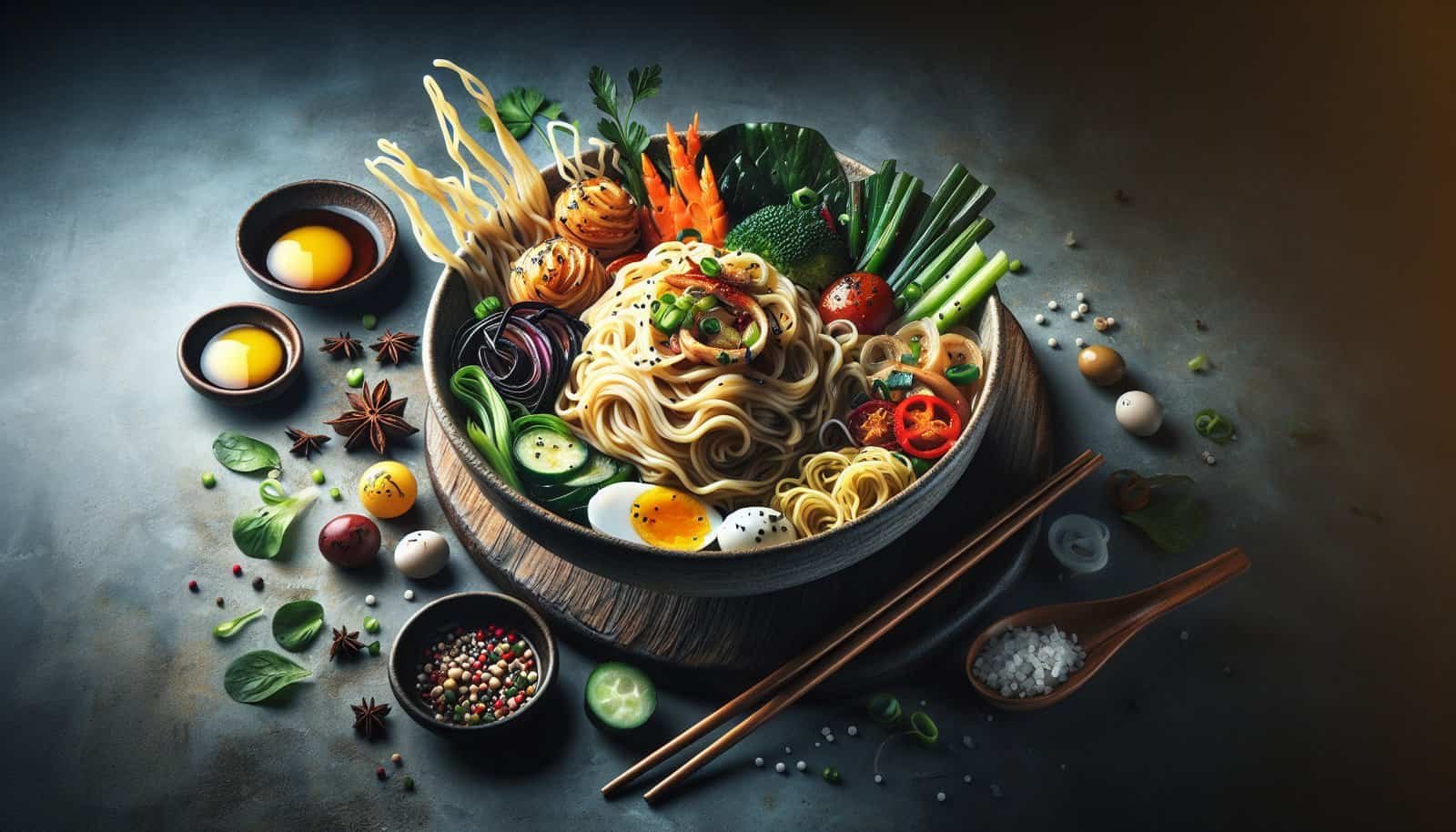
Noodle Stir-Fry Innovations
Stir-Fried Noodles in a Hot Stone Pot
Stir-fried noodles in a hot stone pot, also known as Dolsot Bibimbap, is a flavorful and comforting dish that showcases the versatility of Korean noodles. Heat a stone pot until it’s sizzling hot, then add your favorite cooked Korean noodles and stir-fry them with vegetables, protein, and sauce. The sizzling stone pot creates a crispy and slightly charred layer on the bottom of the noodles, adding a delightful texture and smoky flavor to the dish.
Noodle Pancakes with Crispy Edges
Noodle pancakes are a delicious and innovative way to enjoy Korean noodles in a crispy and satisfying form. Cook your favorite Korean noodles and let them cool slightly. Mix the cooked noodles with beaten eggs and chopped vegetables, then pan-fry the mixture until golden brown and crispy on the edges. The noodle pancakes have a crunchy texture on the outside and a soft and savory filling, making them a delightful twist on the traditional noodles.
Noodle Stir-Fry with Tofu
Noodle stir-fry with tofu is a healthy and protein-packed variation of Korean noodle dishes. Cook your favorite Korean noodles and set them aside. In a hot pan, stir-fry diced tofu with vegetables and sauce until the tofu is lightly browned and the vegetables are tender. Add the cooked noodles to the pan and toss them with the tofu and vegetables until well combined. The tofu adds a meaty texture and a subtle flavor to the noodles, making it a satisfying option for vegetarians or those looking for a lighter meal.
Stir-Fried Noodles with Seafood
Stir-fried noodles with seafood is a flavorful and indulgent dish that showcases the versatility of Korean noodles. Cook your favorite Korean noodles and set them aside. In a hot wok or skillet, stir-fry an assortment of fresh seafood such as shrimp, squid, and mussels with vegetables and a savory sauce. Add the cooked noodles to the pan and toss them with the seafood and vegetables until well coated. The combination of the tender seafood, the crunchy vegetables, and the flavorful noodles creates a delectable and mouthwatering dish.
Spicy Stir-Fried Rice Cakes with Noodles
Spicy stir-fried rice cakes with noodles, also known as Rabokki, is a popular street food in Korea that combines the best of two worlds. Cook your favorite Korean noodles and set them aside. In a hot wok or skillet, stir-fry rice cakes with gochujang (Korean red pepper paste), soy sauce, and other seasonings until the rice cakes are chewy and the sauce is thickened. Add the cooked noodles to the pan and toss them with the rice cakes until well combined. The combination of the spicy and chewy rice cakes with the soft and flavorful noodles creates a highly addictive and satisfying dish.
Noodle Soup Garnishes
Sliced Green Onions
Sliced green onions are a classic and essential garnish for Korean noodle soups. The fresh and mild flavor of the green onions adds a subtle bite and freshness to the rich and savory soup base. Sprinkle sliced green onions over your bowl of noodle soup just before serving to enhance the overall taste and add a pop of color.
Toasted Sesame Seeds
Toasted sesame seeds are a fragrant and nutty garnish that adds a depth of flavor and texture to Korean noodle soups. Toast sesame seeds in a dry pan over medium heat until they become golden brown and fragrant. Sprinkle the toasted sesame seeds over your noodle soup to add crunchiness and a rich aroma. The sesame seeds complement the flavors of the soup and provide a delightful contrast.
Chili Flakes
Chili flakes, also known as gochugaru, are a popular and spicy garnish for Korean noodle soups. Sprinkle a pinch of chili flakes over your bowl of noodle soup to add a kick of heat and a vibrant red color. The chili flakes enhance the spiciness of the soup and give it an extra layer of flavor. Adjust the amount of chili flakes according to your preference for spiciness.
Fried Shallots
Fried shallots are a flavorful and crispy garnish that adds a sweet and savory element to Korean noodle soups. Thinly slice shallots and fry them in oil until golden brown and crispy. Drain the fried shallots on a paper towel to remove excess oil. Sprinkle the fried shallots over your noodle soup just before serving to add a delightful crunch and a rich oniony flavor.
Bean Sprouts
Bean sprouts are a refreshing and crunchy garnish that adds texture and freshness to Korean noodle soups. Blanch bean sprouts in boiling water for a few seconds, then rinse them under cold water to cool them down. Drain the bean sprouts and sprinkle them over your soup. The bean sprouts provide a pleasant crunch and a slightly sweet taste that complements the flavors of the broth and noodles.
In conclusion, Korean noodles offer a wide range of flavors, textures, and presentation possibilities. From classic dishes like Japchae and Naengmyeon to fusion creations like Korean-Mexican noodle tacos and Korean-Italian noodle carbonara, the world of Korean noodle dishes is truly exciting and innovative. By exploring various types of noodles, creative presentations, innovative toppings, flavor combinations, wrappings, fusion dishes, local ingredients, healthy alternatives, stir-fry innovations, and soup garnishes, you can create unique and delicious dishes that will impress your friends and family. So, go ahead and let your creativity run wild with Korean noodles!
